DG Archiv, by way of Bach
As I have already stated on my page dedicated to Stereo LPs made by Deutsche Grammophon Gesellschaft (DGG), I very much enjoy records made by this company. Only briefly did I mention, whilst discussing DGG, their subsidiary label Archiv, or 'Archive' as it was called in English, being the 'History of Music Division of the Deutsche Grammophon Gesellschaft'.
Archiv (as I will keep calling the sub-label) produced some of the most collectible DGG recordings - collectible for their sound and featured artists that is, but not, to be sure, for their artwork. Artwork on Achiv record covers was, up to about 1965, practically non-existent: records were stored in cloth boxes or yellow sleeves with no pictures on them, only lettering, as will become clear shortly. Up until 1965, it seems that Archiv records - or 'Produktions' as they were called by the company - were manufactured with libraries as intended customers, for what was missing in the art department was made up by lavish historical documentation, as we shall see.
Spinnin' Silver!
One distinguishing feature of Archiv artwork should be celebrated: all collectible record labels of Archiv stereo LPs (i.e. the first, second and third labels as shown to the right) feature a wonderful silver coating that reflects wonderfully, especially when the record is spinning on the turntable. Spinnin' silver - wow!
An Archiv crash course, by way of Bach favorites
Now, in the following narrative I will relate something about my favourite Bach on Archiv, and in so doing also give kind of a crash course on the Archiv label in general, mirroring, as concise as possible, my page on Deutsche Grammophon Stereo LPs.
Research Periods
The History of Music Division of DGG was sub-divided in so-called 'Research Periods'. The body of Works by Bach constituted 'Period IX'. This Period IX was meticulously subdivided to cover 'Cantatas', Instrumental Music' and more, but this need not concern us here.
DGG's first ever stereo recording? Bach on Archiv!
Let's start with a very special box set of Bach's Art of Fugue, played on the organ. To be sure, the organ is not an instrument I normally take to, but for recordings made by Helmut Walcha I like to make the occasional exception. Walcha, born in 1907 in Leipzig, was blinded at age 19 but still managed to finish his studies at the Leipzig Conservatory. From 1929 on he lived and worked in Frankfurt. For DGG he recorded two complete Bach cycles: the first, 1947 through 1951, in mono; the second, 1956 through 1971, in glorious, well-defined stereo. Walcha kicked off his second cycle with a recording of the Art of Fugue, made during September 1956 at the organ of the Laurenskerk , a church in the Dutch city of Alkmaar. This recording is something very special indeed, since it was the first ever stereo recording made by the Deutsche Grammophon Gesellschaft. Curiously enough, the first release of the recording, at the end of fifties, was in mono only. The stereophonic version of Walcha's Art of Fugue was only offered to the public in the early sixties. Figure 1 shows the box of the stereo release, the front of this box being absolutely identical to the mono box - a strange and anomalous thing indeed, as will become clear later on.

Fig 1. Front cover of cloth box 'The Art of Fugue', Archiv SAPM 198 006-07
Although the stereo LPs of The Art of Fugue first appeared in the early sixties, the dead wax of the record as shown in figure 2 shows not only the engraved catalogue number of the record, but also an extra number, prefixed with the letters 'LAB'.
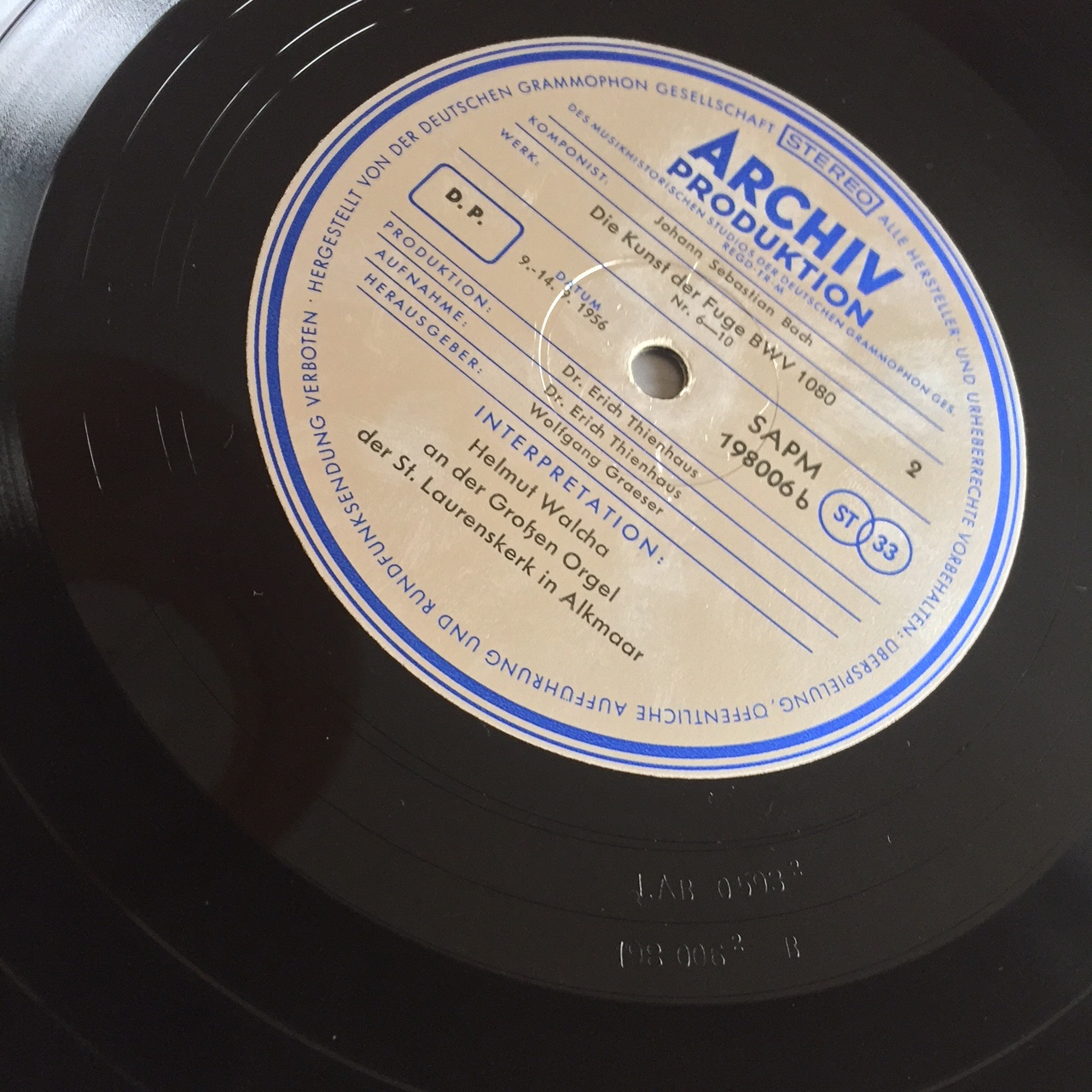
Fig 2. Dead wax of Archiv SAPM 198 006, side 2
The designation 'LAB' seems to be short for 'LABoratory', indicating that these pressings were still something of an experiment. If we are dealing with experimental stereo, as indeed we are, I must say that these pressings sound magnificent, at least when played back on an amplifier equipped with valves.
Impeccable documentation
Let's now have a look at the impeccable documentation accompanying all Archiv records, and the Walcha Art of Fugue edition especially. First of all, there is the Archiv index card, tucked into all boxes and individual sleeves first put on offer 1958 through 1965. The front of the index card for SAPM 198 006-07 is shown in figure 3. Listed are the name, date and edition of the work recorded, as well as recording dates, recording venue, and much more. The back of the index card (fig. 4) in this case lists the sequence of movements played as well as the disposition of the organ.

Fig 3. Front of index card accompanying SAPM 198 006-07
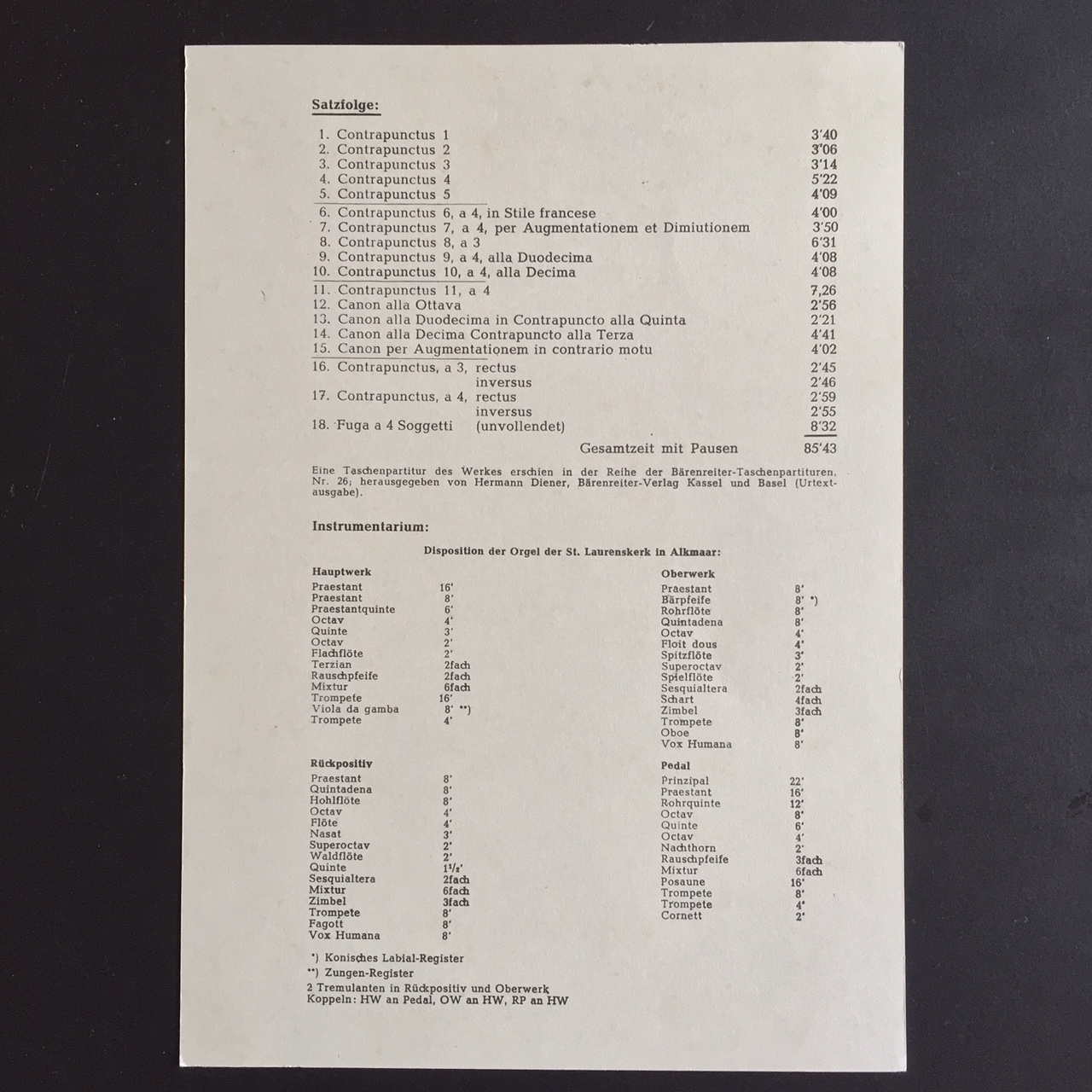
Fig 4. Back of index card accompanying SAPM 198 006-07
And there was much more by way of documentation. The box for Art of Fugue contains a 28 page booklet with essays on the Alkmaar organ, musicological problems encountered, and an explanation by Walcha of his interpretative choices, the whole thing lavishly illustrated with black-and-white illustrations hand-pasted onto paper, as shown in figure 5.

Fig 5. Hand-pasted photo in booklet accompanying SAPM 198 006-07
Clever marketing
One can well imagine what DGG were aiming at in their marketing of Archiv Produktion. In the case of Art of Fugue, the cloth box, index card and lavish booklet all communicated to the prospective buyer that nothing less was on offer here than an exquisitely packaged part of Essential European Cultural Heritage. The minimalist artwork actually helped to impress upon the buyer the fact that he was encountering an Exquisite Product Especially Crafted for Discerning Connoisseurs only. Well! it must have been - and still is, at least to me - a wonderful experience to take out a record set like this and enjoy the possession of such a cleverly packaged Cultural Artifact.
Early Archiv stereo pressings, 1958 - 1960
As far as I can tell, stereophonic Archiv Produktions were first put on offer at the end of 1958, that is to say: about the same time as regular DGG stereo LPs. Now, during the first years of Archiv stereo (1958-1960) records could be stamped with the LAB matrix code as shown in fig 2. Often during these same years, however, the LAB code was missing, and the dead wax of the record was only stamped with the catalogue number of the recording, looking as if printed by a misaligned typewriter. For an example of this, see figure 6.

Fig 6. Example of 'misaligned typewriter' matrix code
During the years 1959-1960 and for some time thereafter, a box set of stereophonic Archiv records proudly announced 'stereo' on its front. See for example the very nicely done front of a box presenting all six Brandenburg concertos by Bach, shown in figure 7. Compared to this, the box set Art of Fugue (fig. 1) really is an anomaly.
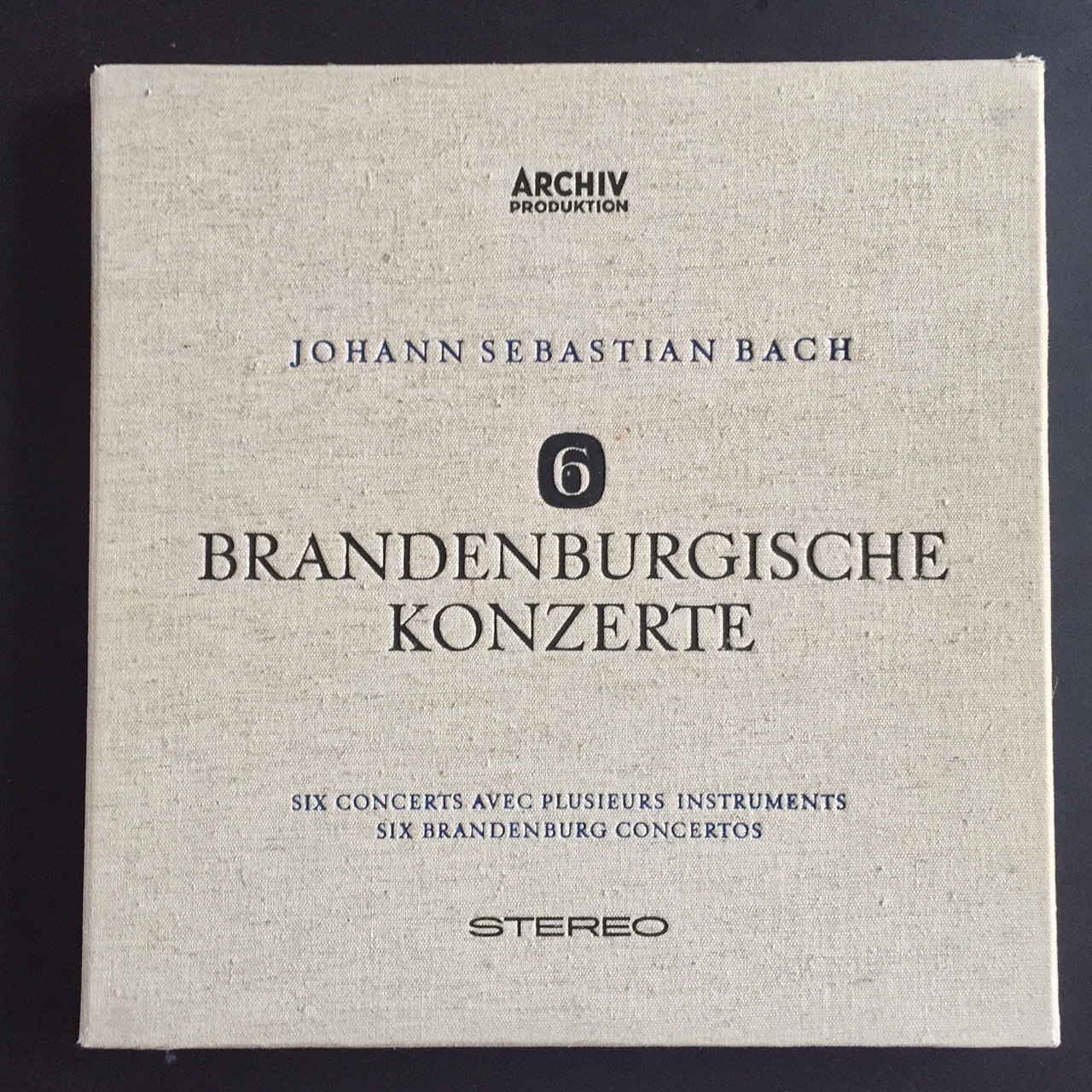
Fig 7. Front cover of cloth box 'Six Brandenburg Concertos', SAPM 198 142-43
Festival Strings Lucerne play Bach
But now, let me tell you some more about the recording of the Brandenburg concertos by the Festival Strings Lucerne. This group was founded 1956 by violinists Wolfgang Schneiderhan (1915-2002) and Rudolf Baumgartner (1917-2002), the latter acting as leader of the group. Through Schneiderhan, already under contract to the Deutsche Grammophon Gesellschaft, the Festival Strings quickly signed on with Archiv. In 1959 and 1960 they committed the six Bach Brandenburg concertos to tape for the company, in well-defined stereo. The recordings were released as individual records SAPM 198 242 and 198 243 and also together, in a trademark Archiv cloth box stamped SAPM 198 142-143 (pictured above). Both SAPM editions may be hard to find, but luckily for us collectors, the Baumgartner-led Brandenburgs were included in a set of Bach instrumental works released by Archiv as a special subscription set in 1963: as records SKL 122 and 123 the Baumgartner Brandenburgs shared a cloth box with the four Bach suites for orchestra (SKL 124-25) and the musical offering (SKL 126), all conducted by Karl Richter in what are, regretfully, sub-standard interpretations. The SKL Bach box isn't hard to find, and should not be expensive at all.
Well-integrated soloists
Now to the important question why you should seek out the Festival Strings Lucerne's take on the Bach Brandenburg concertos. It’s simple really: the Strings offer utterly, well integrated Bach playing by rather famous soloists. For, apart from Schneiderhan and Baumgartner on violins, the Brandenburg recording by the Festival Strings features, among others, Helmut Winschermann on oboe, Adolf Scherbaum on trumpet, Hans-Martin Linde on recorder, Aurèle Nicolet on flute, and Ralph Kirkpatrick on harpsichord. Furthermore, I for one particularly like the relaxed, unhurried way of music making this group displays. Eventually, I think, you will like this way of playing too, although it may take some getting used to; I know it took me some time, weened as I was on the now current 'Bach on steroids'.
A DG SLPM disc sneaked in
Incidentally, I’d like to mention that although the Festival Strings Lucerne started out playing music of the baroque era, they pretty soon added romantic and especially modern music to their repertoire. Only a few of their interpretations of modern music were released by the Deutsche Grammophon Gesellschaft: some trifles by Bartok and Hindemith on SLPM 138 021, and also the more substantial Respighi cantata ‘Il Tramonto’ on SLPM 138 086. On the latter LP, the Respighi is coupled with the famous Bach Wedding Cantata BWV 202 ('Weichet nur, betrübte Schatten’) and hence this disc is relevant to my narrative here; allow me to sneak it in.
Husband and wife
Please note that the Respighi and Bach texts on 138 086 are sung by soprano Irmgard Seefried, wife of violinist Wolfgang Schneiderhan. Seefried, Schneiderhan and the Strings bring off beautiful interpretations of both the baroque and the modern work. Let me here include the record sleeve of SLPM 138 086, if only because it so nicely pictures wife (l) and husband (r), surrounded by players of the Lucerne Strings.
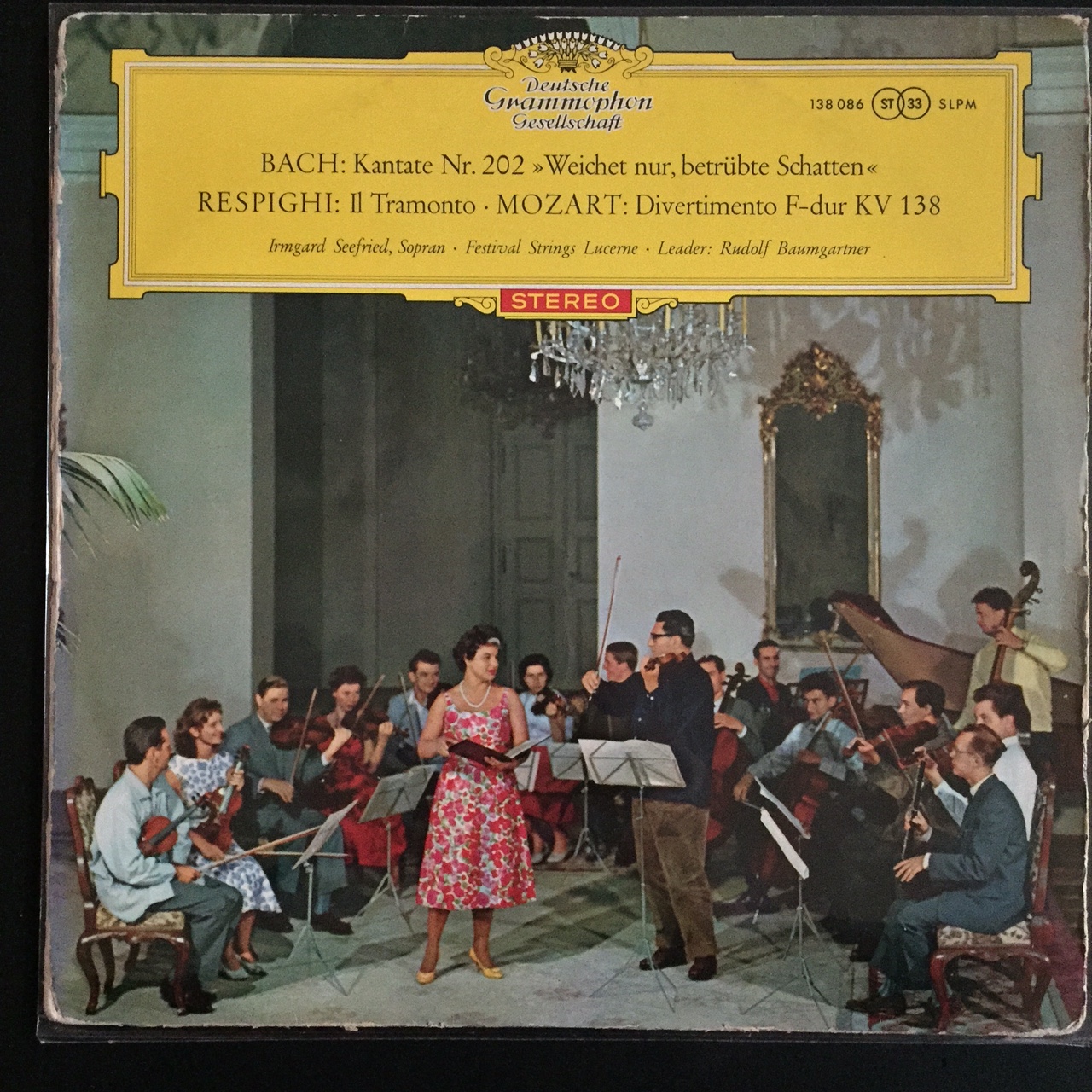 Husband & Wife: Schneiderhan, center right, & Seefried, c. left, amid the Festival Strings
Husband & Wife: Schneiderhan, center right, & Seefried, c. left, amid the Festival Strings
Yellow sleeves, marked 'red stereo'
Thus far, I have only referred to Archiv box sets. Let's have a look now at individual Archiv discs, packaged in fold-out sleeves. These were elaborate: the plastic inner sleeve of each fold-out was stitched to outer sleeve paper. Elaborate fold-out sleeves, always made with paper distinctly colored as 'DGG yellow', were produced for all new individual releases 1958 through 1965. This is approximately the same period when almost all regular DGG sleeves sported the famous yellow cartouche, as described elsewhere. These regular DGG LPs also carried a 'red stereo' notice, either in the form of a sticker pasted onto the sleeve, or in the form of a 'red stereo' rectangle printed at the base of the DGG-cartouche; see my page on DGG Stereo LPs. As a matter of course, during the years 1958-1965 a 'red stereo' notice was also printed on Archiv sleeves: we find a printed 'red stereo' rectangle in the top right corner of each and every one of them, as shown in figure 8.
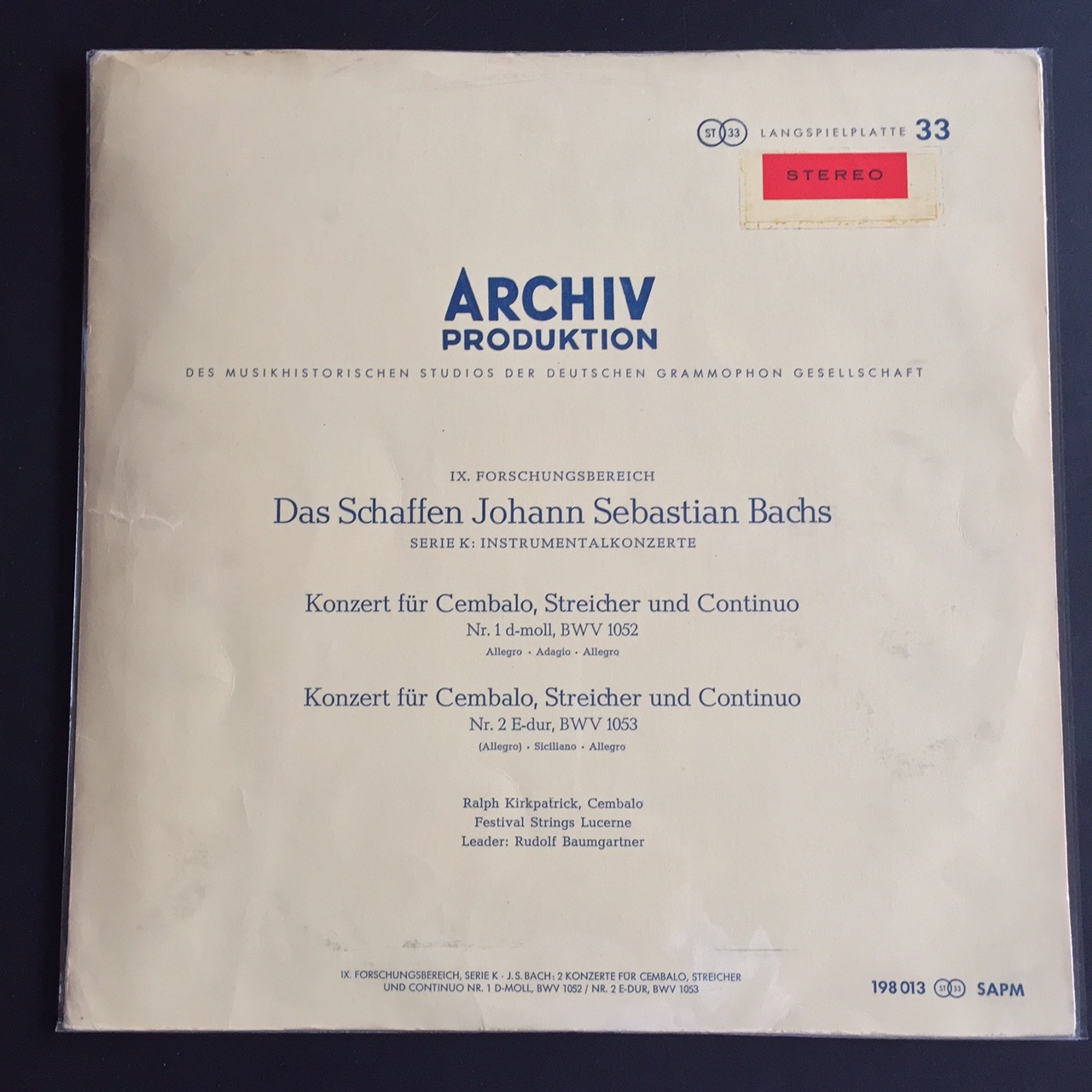
Fig 8. Front cover of a typical Archiv 'yellow sleeve' (SAPM 198 013), with 'red stereo'
The artist featured in fig 8., Ralph Kirkpatrick (1911-1984), was an American harpsichordist who recorded extensively for Deutsche Grammophon and DG Archiv during the fifties and sixties. I will discuss his work in more detail on a special harpsichord page I hope to create soon. For now, let me briefly state that all Kirkpatrick recordings for Deutsche Grammophon / DG Archiv should be considered very collectible.
Pressings 1960-1966
Now, during the years 1960-1966, DGG took a big step, sound-wise, as explained elsewhere. Archiv records of this same production period can be easily identified, first of all by a distinct curved 'stereo in a box' mark that every record carried at the top of the label. This mark, incidentally, was already in use during 1959.

Fig 9. Close-up of curved 'stereo in a box', printed at the top of an Archiv record label
The curved 'stereo in a box' mark is something collectors consider to be the equivalent of the 'Alle Hersteller' copyright notice found on regular DGG LPs (discussed elsewhere). This is especially so since to the right of the mark, the text 'Alle Hersteller' appears on Archiv record labels as it does on regular DGGs from the same production period (see fig. 9).
The second distinguishing mark of Archiv records manufactured during the production period 1960-1966 is the disappearance of misaligned matrix numbers: 'regular' matrix numbers as shown in figure 10 appear in their stead.

Fig 10. Example of 'regular' matrix code
Archiv as 'Archive'
Now let me digress a little and introduce you to Archiv records specifically intended for the American market. These records were called Archive and packaged not in elaborate fold-out, but quite normal record sleeves. These sleeves carried a distinctive catalogue number starting with 'ARC'. In fig 11 this number is shown in the upper right corner of the sleeve. The normal (German) catalogue number is also printed, to be sure: it is found in a blue box that is placed in between the 'ARC'- number and the 'red stereo' notice.

Fig 11. Example of typical 'yellow sleeve' Archive Production (ARC 73144)
Because sleeves produced for the European market were manufactured as elaborate fold-outs, they could contain a lot of information. The same amount of information was generally too voluminous to put on the back of an ARC-sleeve, so the index cards of ARC-productions were expanded, as shown in figure 12.
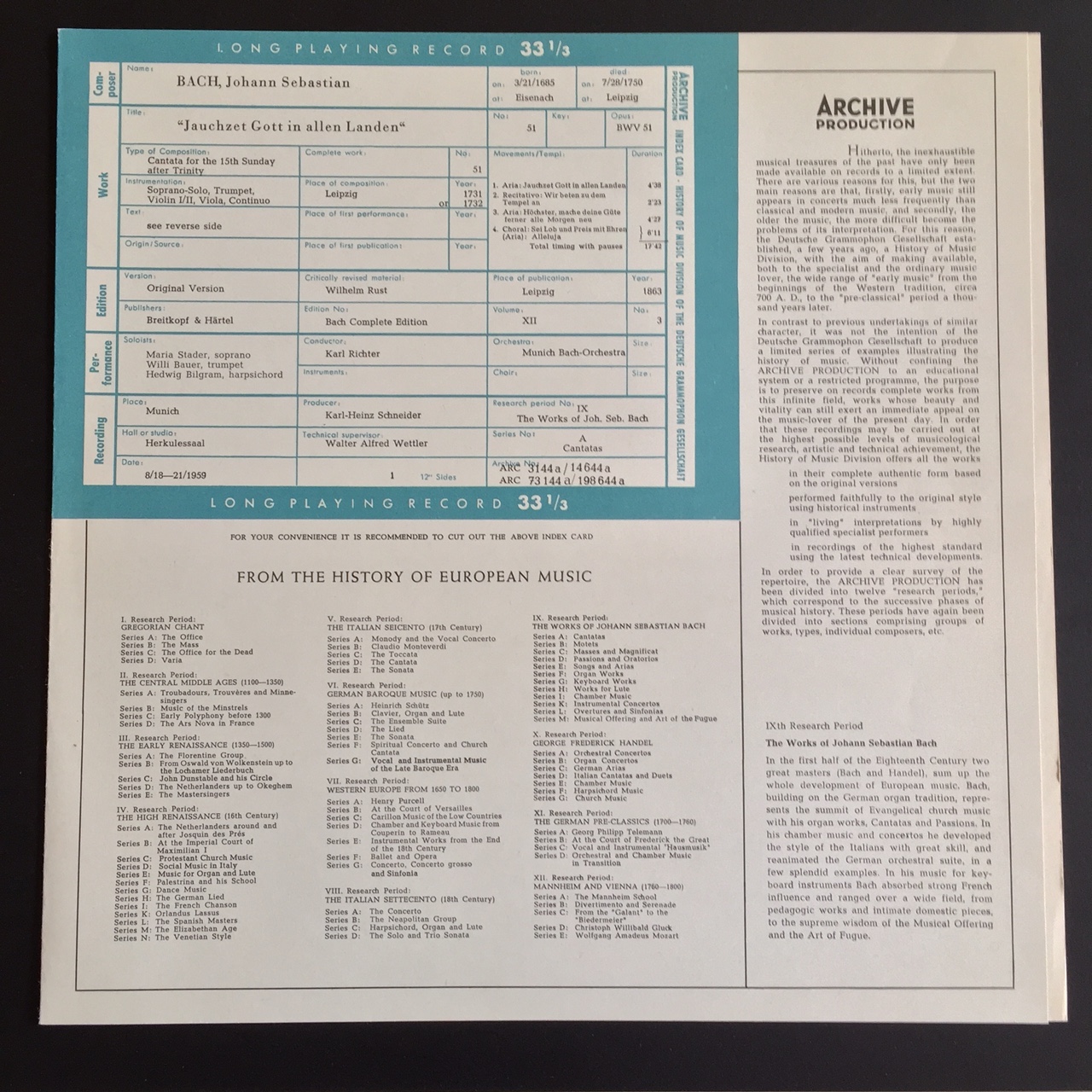
Fig 12. Example of typical ARC 'expanded index card' (ARC 73144)
Archiv records produced 1966 - 1970
During 1966, DGG discontinued mono releases of all new productions. As if to mark this occasion, regular DGG LPs saw their copyright notice changed from 'Alle Hersteller' to 'Made in Germany', as I explain elsewhere. On Archiv LPs the distinct curved 'stereo in a box' was eliminated, and a 'made in Germany' notice put in its place. For an example of the new look: 'made in Germany' in the place of 'stereo in a box', see figure 13.
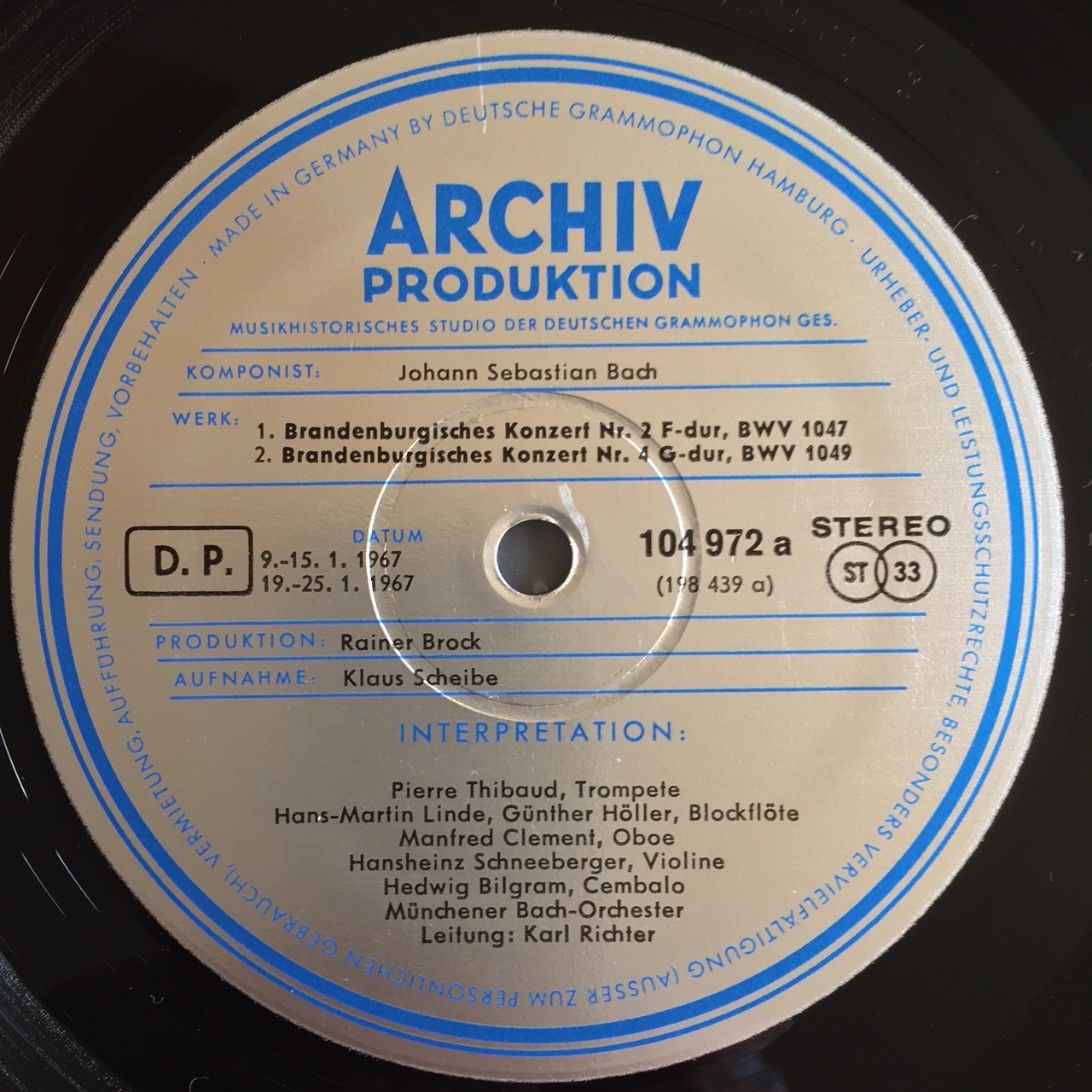
Fig 13. 'Made in Germany' replaces the 'stereo in a box' at the top of the record label
1965: A major artwork make-over for box sets
Just before the disappearance of the distinctive 'stereo in a box'-mark, DGG had decided, somewhere during 1965, that their Archiv productions were in need of more appealing artwork. Younger generations seemed to no longer 'get' that a sober outlook stood for exclusivity, and so it was decided that pictures needed to be introduced. This, however, could only be done in a way that would not put off collectors of the older generation, who very much subscribed to the old, sober packaging. At the DGG art department, an excellent compromise was found. From 1965 onwards, all Archiv box sets were adorned with monochrome pictures printed on shiny silver paper that perfectly evoked the shiny silver used on the labels of actual records contained within the box. The introduction of pasted-on shiny illustrations made for a marked contrast with earlier editions of the very same sets, to be sure, but continuity was maintained through the continued use of the trademark Archiv cloth. See for yourself: compare figure 14, the original box of Bach's Matthew Passion, with the later edition as shown in figure 15.
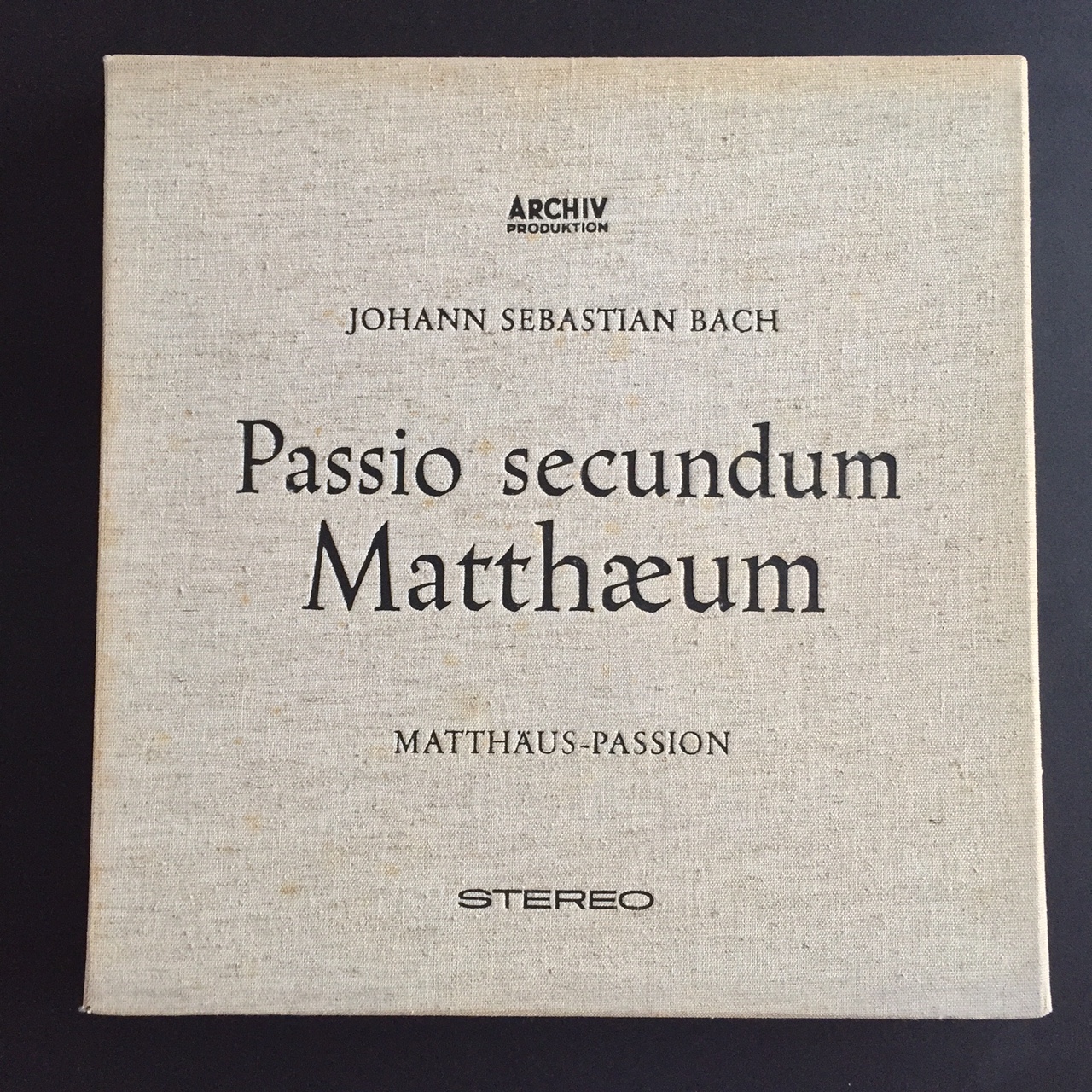
Fig 14. Box of Matthew Passion, first edition (SAPM 198 009-12)
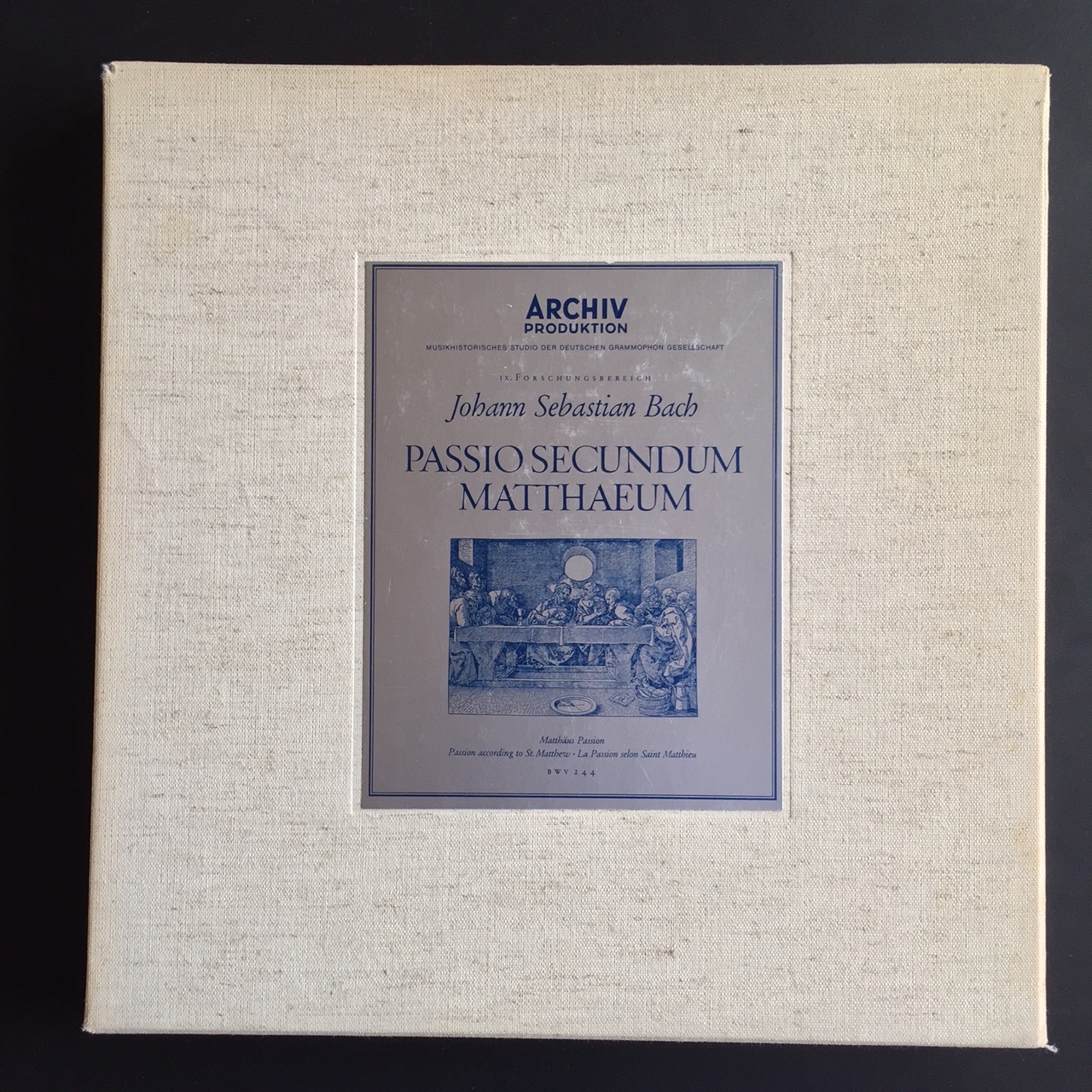
Fig 15.Box of Matthew Passion, second edition (so: also SAPM 198 009-12
Bach specialist Karl Richter
Karl Richter (1926-1981) was, during the sixties, one of Archiv’s most prominent conductors. Born and educated in the Eastern part of Germany, Richter briefly served as organist of the Leipzig church of St Thomas (Thomaskirche) before moving, in the early fifties, to Munich, in what was then the Federal Republic of Germany (‘West Germany’). In Munich, Richter taught at the conservatory, directed the Munich Bach Orchestra and Choir, and acted as cantor and organist of the Church of St Mark. After Richter had made some recordings in both mono and stereo for the German Telefunken and British Decca label respectively, the Deutsche Grammophon Gesellschaft was able to sign him just as his reputation was taking off internationally. For the DG Archiv label, Richter made a plethora of recordings. Especially his Bach is still sought after to-day.
A spiritual event
Most prized of Richter's Bach among collectors is probably his Matthew Passion, recorded during the summer of 1958 and featuring, amongst others, Ernst Haefliger, Kieth Engen, Irmgard Seefried, and Dietrich Fischer-Dieskau as soloists. The box of this recording is pictured above, in both its first and second edition. There was a time when a copy of the first edition of this recording could fetch hundreds of euros, but thankfully this is no longer the case. Nowadays it can be snapped up for less than a hundred, often even less than fifty. I say: don’t pass it up when you come across it, for Richter’s Passion is a true spiritual event. He displays nothing of the inappropriate haste with which some musicians currently dispatch Bach’s divine music, no: Richter involves you in a thorough, profound interpretation that simply must be experienced, if only once.
More Bach by Richter
Besides the St Matthew Passion (SAPM 198 009-12), Richter also recorded Bach’s monumental Mass in B (198 190-92), the St John Passion (198 328-30), the Bach Christmas Oratorio (198 353-55), the Magnificat and many, many Bach cantatas. A fine example of a Bach cantata recording by Richter is the famous BWV 51 ('Jauchzet Gott in allen Landen'), SAPM 198 644, pictured above in its Archive incarnation (ARC 73144). Listen to this record, and enjoy the virtuoso interplay between the trumpet and soprano Maria Stader during the opening aria of the cantata.
A Samson to sample
Richter not only recorded all major Bach works, but also quite a lot of Handel. To be honest: his interpretations of the latter composer’s music were quite controversial at the time, as they still are now. In case you wish to explore Richter in Handel, let me point you to a recording that should be given a listen in its own right: as a real feat of audio engineering, that is. I'm talking about Handel’s Oratorio Samson, recorded 1968, with a fabulous cast including the incomparable Alexander Young. It is a common enough Archiv box in the second-hand market, numbered 198 461-664 or 643 517-20.
Richter into space
As a rule, recordings of instrumental music made by Richter to our ears often sound stodgy and even quaint. There are happy exceptions to this rule, however, the most important being a set of complete Brandenburg concertos (198 438-39), released at the end of the sixties to near universal acclaim. This set was initially offered as a subscription set at a fairly reduced price and, in this form (104 971-72), acquired by thousands of music-lovers the world over. Given their wide circulation, these Brandenburgs can be yours for only a few euros. Buy them, I say, and listen to Richter and his merry band throwing themselves into the music with complete abandon, whilst remaining in full control. Bach here almost sounds modern: ‘jazzy’, as it were. Give a special listen to concerto number five, in which Richter himself shows off his considerable skill as a harpsichordist. Take note, also, of this fun fact: the allegro of number two Brandenburg concerto as interpreted by Richter was included on the Voyager Golden Record and, 1977, sent into space on board the Voyager I and II spacecrafts.
A Richter rarity
Another recording of instrumental music by Richter I cannot fail to recommend is his foray into Haydn, on this occasion conducting the famous Berlin Philharmonic. This recording was released not on Archiv but as a regular Deutsche Grammophon LP: SLPM 138 782.
A make-over for sleeves: yellow to grey
Returning to our discussion of the change effected around 1965 in the packaging of Archiv records, let us now turn from box sets to individual record sleeves. Here, a very substantial make-over was effected. From 1965 on, for all new productions (and later for most old productions as well) the distinct 'DGG-yellow' of the sleeves was changed over to a very distinguished grey hue. This grey very nicely set off the tasteful picture that was introduced on the sleeve-front. At first, pictures were reproduced in blue monochrome, but pretty soon they were printed in more colors, eventually becoming full color illustrations. Furthermore, at the very start of the make-over of sleeves, the borders of both the front and the back were ornamented with a new pattern, also in blue. This pattern immediately took off with the public (as it was intended to) as 'trademark Archiv'. Finally, the all-out make-over of Archiv sleeves did away with the index cards as separate items: inserts were simply dropped, and the information contained on them was handsomely integrated into the new sleeve-design. The end-phase of this altogether startling make-over of sleeves is shown in figures 16 and 17.
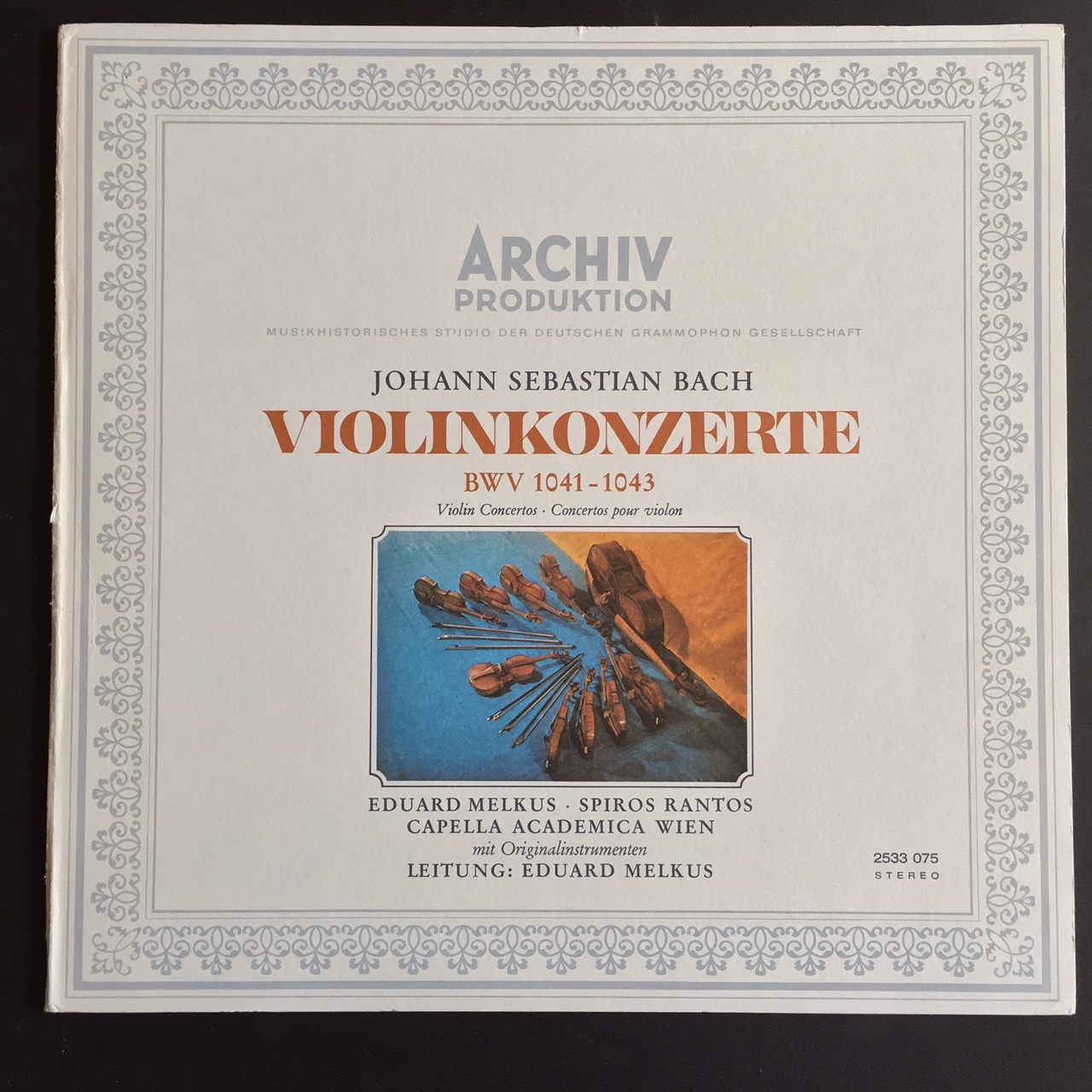
Fig 16. Typical Archiv 'grey sleeve' front; late model, with full color illustration
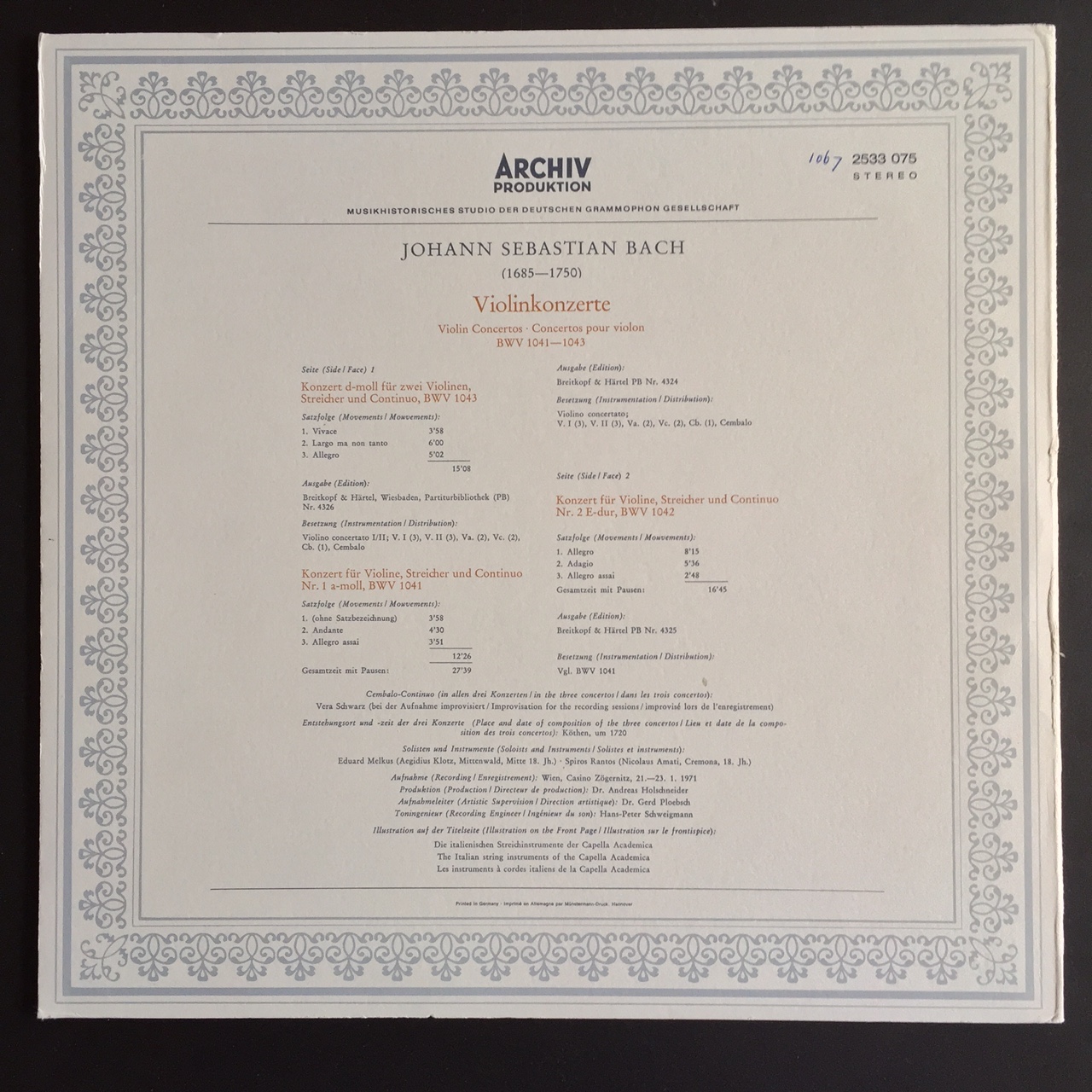
Fig 17. Typical Archiv 'grey sleeve' back, quasi doubling as 'index card'
Coda: Archiv records from the early seventies
During 1969, DG made over the labels of their regular stereo LPs: the elaborate, highly characteristic tulip border was replaced by a new, blue-white border line, strongly resembling the blue lines that had, for more than a decade, adorned the labels of Archiv LPs. Now, regular DGG and Archiv LPs started to strongly resemble each other, and apparently the Powers that Be at DGG soon decided they did not like this. Somewhere during 1971 or 1972, the border lines on Archiv records were dropped altogether, creating the rather austere look as shown in figure 18.

Fig 18 Example of the austere looking late Archiv record label (2533 075), with 'groove'
An all-important groove
Please note, in figure 18, the all-important groove at about 1 cm from the spindle-hole. This groove is an essential guarantee for the quality of the pressing, as I argued in more detail in my discussion of regular Deutsche Grammophon Stereo LPs.
All but forgotten Eduard Melkus
Let me finish thishere page dedicated to Deutsche Grammophon Archiv by drawing your attention to the last recording shown, for that is a fine Archive production indeed, featuring the great Eduard Melkus. Born 1928 in Baden near Vienna, Melkus used to be known as a talented player of both the violin and the viola. All but forgotten today, he nonetheless made an important contribution to the introduction of Historically Informed Practice (HIP), recording for Archiv during the sixties and early seventies. His style is remarkably personal, characterized by easy recognizable vibrato. This vibrato plus the fact that Melkus kept to modern pitch made sure that his status was lowered to that of ‘only a halfway HIP-ster’ as soon as a generation of new, sterner HIP musicians, critics and patrons came to the fore, say halfway during the seventies. Until to-day, his reputation has not recovered. For collectors this is rather a good thing, since all of his records can be bought cheap, except for the award-winning set of Biber Rosary Sonatas (198 422-23) which at online auctions regularly fetches quite outrageous prices.
Recommended Melkus LPs
Besides the Bach LP shown above (2533 075), I would like to steer collectors toward Melkus’ interpretation of a violin concerto by Pisendel (198 366); Tartini and Nardini violin concertos (198 370); Handel violin sonatas (198 474/75); a short concertino fugato by Monn (2533 048) and last but not least a rather hard-to-find (but still inexpensive) record dedicated to Polish Hanakian folk music as found in the works of Telemann (198 467). Enjoy them all!
[Page corrected October 5th, 2020]

First Archiv record label (1958-1966 approx.)

Second Archiv record label (1966-1971 approx.)

Third Archiv record label (1971-1972 approx.)



